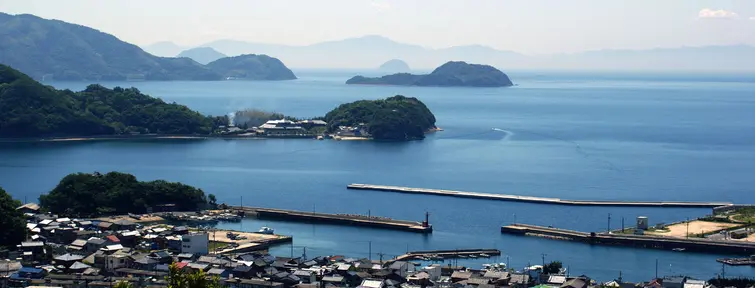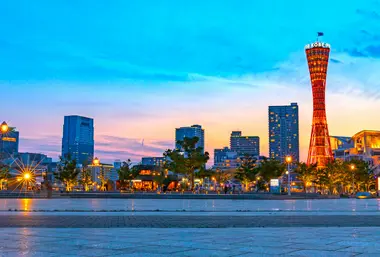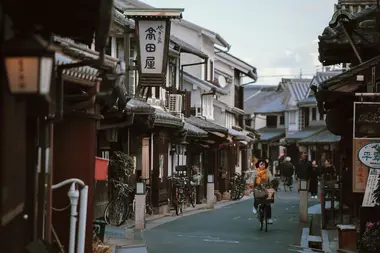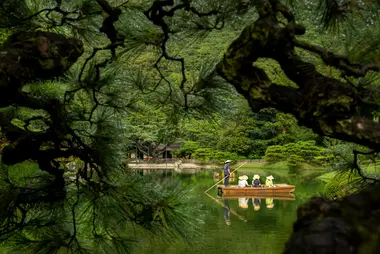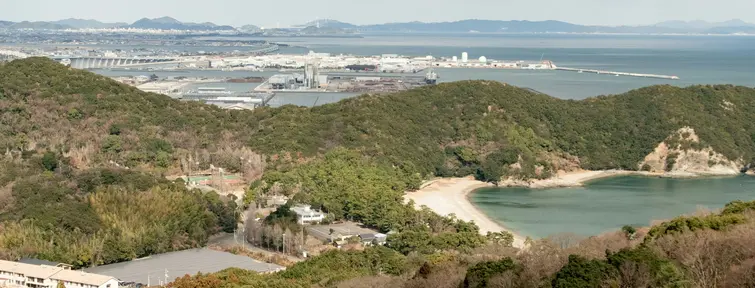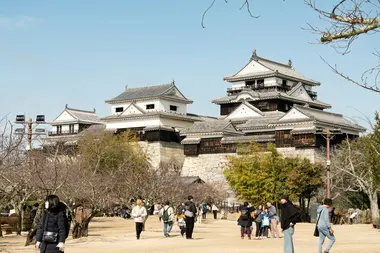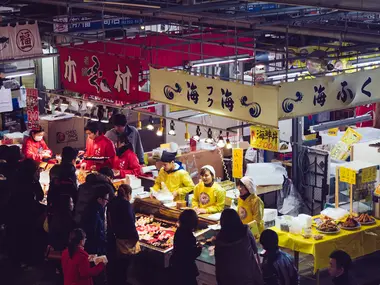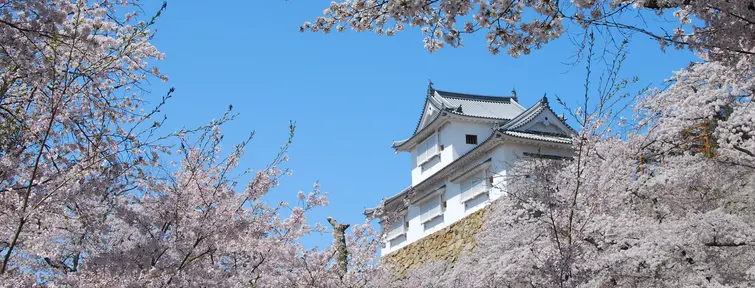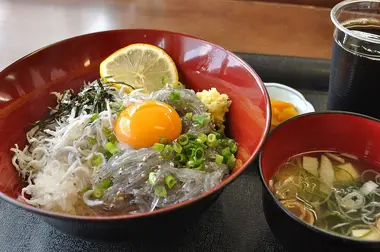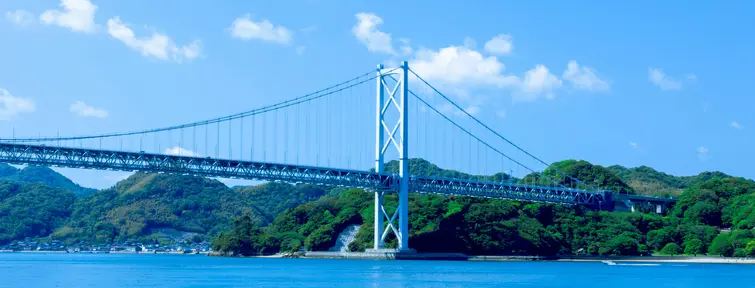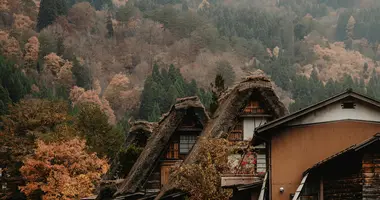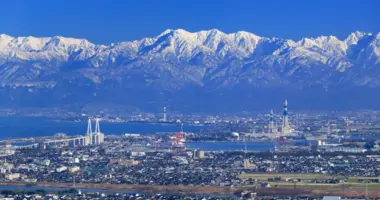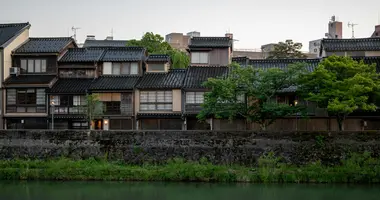Travel the Setouchi region by train: What to see and do around Japan's Inland Sea
- Published on : 05/09/2025
- by : Phoebe
- Youtube
Between the islands of Honshu and Shikoku, the Setouchi Inland Sea is an exceptional cultural basin. Encompassing seven prefectures, it offers a multitude of landscapes and activities not to be missed on a trip to Japan. Urban centers, country towns and small fishing harbors—the region's eclectic atmosphere is truly captivating. But it's above all for the Triennale that it's famous throughout the archipelago—a contemporary art festival held here every three years. What is there to see and do around Japan's Inland Sea? Japan Experience introduces you to the region with the Setouchi Area Pass.
7 days of discovery by train with the Setouchi Area Pass
The Setouchi Area Pass takes you along the waters of the Setouchi Basin. From Kansai to Fukuoka, spend 7 days crossing the country's major cities , including Kyoto, Kobe, Hiroshima and Takamatsu, and discover the hidden treasures that dot Japan's inland sea. The pass allows you to use several rail lines:
- jR lines in the region
- sankyo Shinkansen (Hello Kitty Shinkansen included)
- okayama Electric Tramway
- jR Bus Chugoku (Hiroshima Meipuru)
- hiroshima Bus (Hiroshima Minato New Route)
As well as a number of ferries, such as the Shodoshima Ferry, the Ishizaki Kizen or the JR West Miyajima Ferry.
For more information on the destinations served by the pass, visit the official Setouchi Area Pass website.
7 prefectures to visit in a week
Not counting the prefectures of Kyoto, Osaka and Fukuoka, the Setouchi Area Pass allows you to discover seven more confidential regions.
Hyogo
Famous for its rice, meat and sake, Hyogo prefecture is a nice stop for anyone wanting to learn more about these iconic Japanese foods. Take advantage of the craft breweries in the Nada district, east of Kobe. The Kiku-Masamune brewery, with its 350-year history, is renowned throughout the country for its dry sake. A few steps away, try Kobe beef in one of the city's many restaurants. Weather permitting, stroll along the harbor, one of Japan's largest.
Ideal length of stay: 1 day
Okayama
In addition to Okayama, the capital of its prefecture, the surrounding villages offer an unusual cultural break. At Kurashiki, in the Kojima district, Kojima Jeans Street revisits the wearing of denim, with numerous boutiques, customization workshops and even a museum! Discover Bikan by boat, Kurashiki's historic district. Traditional houses and white-walled warehouses in kurazukuri style line the canal for a one-of-a-kind visit. A 40-minute drive away, the heights of Mount Washu offer a breathtaking view of the Seto Bridge, which links Kojima to Sakaide in Kagawa prefecture.
Return to Kurashiki for the night, where the Kurashiki Ryokan overlooking the canal welcomes you. Once used as a residence and rice storehouse, the ryokan has been renovated into eight exceptional rooms, all designed to offer optimum comfort.
The next morning, before your next destination, head for Bizen Osafune, the Japanese sword museum. The town of Osafune has long thrived on sword production. In addition to the manufacturing process and unique exhibits, the museum offers an introduction to paper-cutting, as well as to the care and maintenance of swords.
Ideal length of stay : 1? days
Kagawa
Kagawa prefecture will delight plant lovers. Voted one of the most beautiful Japanese gardens in the country, the Ritsurin Garden is a masterpiece dating back to 1625. It took over a hundred years to complete. Idyllic in every season, the garden boasts more than 1,400 carefully pruned pine trees, as well as a large number of cherry, plum and other flowering trees. In addition to the ponds, small hills add a significant relief to the landscape. Stroll along the winding paths, visit the garden by traditional boat and stop off at a tea house to recharge your batteries.
Ideal length of stay: half a day
Tokushima
Tokushima prefecture is best known for the Naruto whirlpools, impressive marine vortexes up to 30 meters in diameter. Observe the phenomenon from the Onaruto Bridge, which links Tokushima to the island of Awaji, before continuing on to Kobe and Osaka. For more fun, take one of the tourist boats that ply the waters. The Aqua Eddy has windows one meter below the surface, allowing you to get up close to the whirlpool while observing it from the inside to better understand the phenomenon. Once back on dry land, familiarize yourself with the arts of the prefecture. The Otsuka Art Museum, in Naruto Park, houses over 1,000 masterpieces by all the great artists of history (Van Gogh, Rembrandt, Vermeer—among others). But Tokushima is also famous for its "Japanese blue," a highly prized indigo in the textile industry. The prefecture is the leading producer of Sukumo, the essential ingredient of this singular pigment. Visit the workshops in Tokushima. Some even offer the chance to try your hand at the art of dyeing.
Ideal length of stay: 1 day
Ehime
Start your visit at Matsuyama Castle. Built between 1602 and 1628, it is one of only twelve castles in Japan to have survived the Edo period (1603-1868). It offers incredible panoramic views over the city to the Seto Inland Sea. For medieval re-enactment enthusiasts, it's possible to rent armor and practice swordplay. Spend the night at Yamatoya-Honten, one of the oldest ryokans at Dogo Onsen. This thousand-year-old spa is one of Japan's jewels. With its old-world charm and healing waters, it's an ideal stop-off point on your itinerary. Taste Japanese kaiseki cuisine and enjoy Noh theater performances every evening before dinner.
Ideal length of stay : 1 day
Hiroshima
Hiroshima, capital of the eponymous prefecture, needs no introduction. Visit the Peace Memorial Park. In addition to the Atomic Bomb Dome, the park boasts 35 memorials, including the Flame of Peace and the Bells of Peace, as well as a museum as instructive as it is moving. After lunch, take the ferry to the island of Miyajima. A UNESCO World Heritage Site, it is home to the Itsukishima Shrine and its floating torii, one of the most famous in Japan. End the day at the Iwaso ryokan.
Its traditional buildings offer a peaceful view of the inland sea and Momijidani Park, famous for its flamboyant maple trees in autumn. Indoor and outdoor onsen, kaiseki cuisine and attentive service make this an exceptional place to experience authentic Japanese hospitality.
Ideal length of stay : 1 day
Yamaguchi
In Shimonoseki, the Karato market is one of the liveliest fish markets in the country. From 5 a.m. to 3 p.m., it attracts traders and gourmets from all over the region, eager for good food. Have lunch in one of the market's restaurants or sample some sushi at one of the passing stalls. Not far away, the Akama-jingu shrine and its immense torii dominate the Kannon Strait, which separates the main island of Honshu from the southern island of Kyushu. Erected in memory of the infant emperor Antoku, who died in the naval battle of Dan-no-ura in 1185, it combines the history and legend of the Heike and Genji clans. Its elegant architecture and peaceful gardens make it a cultural landmark of the region.
In the afternoon, off to Yamaguchi. Joei-ji Temple, over 500 years old, is home to the Sesshutei Zen Garden, designed by the Buddhist monk Sesshu, a renowned Japanese painter and calligrapher. The garden is divided into two parts: an inner dry garden, made of white pebbles, and a more classical Zen garden. Take a stroll through the garden before catching the train to Yuda Onsen (only ten minutes from Yamaguchi Station). Legend has it that the properties of Yuda Onsen's waters were discovered when an injured fox plunged into them. Among the 30 ryokan that make up the spa, stay at Kokian, with its lush green exteriors. From October to March, you can enjoy fugu, the puffer fish with the deadly venom. Rest assured, the chefs at Yuda Onsen are licensed to cook it safely.
Ideal length of stay: 1 day
A pleasant region in every season
Each season has its own charm in Setouchi.
- In spring, admire the flowers in the local gardens. Tsuyama (Okayama) and Shiyudeyama (Kagawa) are prime destinations.
- In summer, Setouchi's festivals are in full swing. Don't miss Tokushima's Awa-Odori dances. For outdoor enthusiasts, it's also an opportunity to explore the prefectures by bike and boat.
- In autumn, the basin is ideal for hiking. The mild weather and red leaves add to its charm.
- In winter, Setouchi is best appreciated for its gastronomy. Oysters, fugu and seafood, let yourself be tempted by local flavors.
A gastronomic hub not to be missed
The Setouchi region has many specialties:
- Seafood: the Seto Inland Sea abounds in fish and shellfish, including Hiroshima oysters, clams and octopus, often served grilled or as sashimi.
- Shirasu: these small white fish are popular in the Setouchi basin and are often eaten raw over rice or fried into fritters.
- Dried bonito (Katsuo): used to prepare broths or served grilled, this is an essential product of Japan's inland sea.
- Yamaguchi fugu: this globe fish is poisonous and requires a state license to be prepared.
- Kobe beef: originally from Hyogo, this beef is renowned the world over for its tenderness.
- Udon and somen: these noodles are often served cold in Kagawa and Okayama.
- Setouchi lemons: in Ehime prefecture, citrus fruits are prized for their delicate fragrance. They are used in desserts, sauces and drinks.
- Hyogo sake
The Setouchi Triennial: an event not to be missed
Every three years, the Setouchi Triennial brings the region's 12 islands to life. Over three sessions (spring, summer and autumn), this international festival of contemporary art showcases art installations, sculptures and ephemeral works of art in Setouchi.
The port of Takamatsu is the ideal base from which to reach the various islands, offering direct connections to six of them. The Port of Uno, near Okayama, also offers connections to four other islands.
The islands in the western part of the Setouchi region (which mainly take part in the autumn session) can be reached from various ports in Shikoku: Marugame, Tadotsu and Miyanoshita. These towns can be reached by train from Takamatsu Station.
Read more about the Setouchi area!
- Seto Inland Sea
- Naoshima Island
- Teshima Island
- Honjima Island
- Ibukijima Island
- Awashima Island
- Shamijima Island
- Takamijima Island
- Kosan-ji temple
- Myths of the Seto Inland Sea islands
- Battles and legends in the Seto Inland Sea
- Pirates and fighters of the Seto Inland Sea
- The yôkai of the Seto Inland Sea
- Naoshima's open-air works of art
